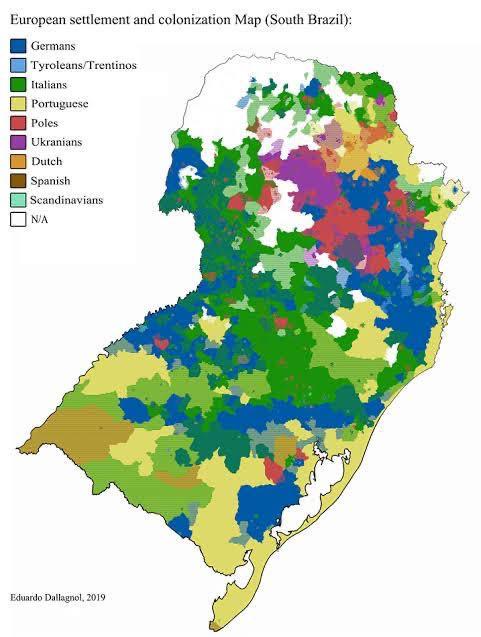European Settlement and Colonization Map of South Brazil


Marcus Rodriguez
Historical Geography Expert
Marcus Rodriguez specializes in historical cartography and geographic data analysis. With a background in both history and geography, he brings unique...
Geographic Analysis
What This Map Shows
The "European Settlement and Colonization Map of South Brazil" offers a detailed overview of the regions in southern Brazil that were significantly influenced by European settlers. This visualization highlights areas where European immigration and colonization have shaped demographics, cultural landscapes, and economic development. It provides insights into the patterns of settlement, the origins of these immigrants, and the lasting impact of these influences on the present-day social and cultural fabric of Brazil.
Deep Dive into European Settlement in South Brazil
European settlement in South Brazil, particularly during the 19th and early 20th centuries, was marked by substantial waves of immigration, primarily from countries such as Germany, Italy, Poland, and Spain. This influx was largely driven by the promise of land, the availability of jobs in agriculture and industry, and the search for better living conditions.
One of the most significant regions highlighted in this map is the state of Rio Grande do Sul, which became a hub for German immigrants. The arrival of these settlers led to the establishment of numerous towns, such as Nova Petrópolis and Gramado, where German customs, architecture, and traditions remain prominent today. Interestingly, the influence of these settlers is still evident in local festivals, culinary practices, and even language, with German dialects being spoken in some communities.
In addition to German migrants, Italian immigrants, particularly from the regions of Veneto and Friuli, found their way to South Brazil, especially in the states of Santa Catarina and Paraná. They were instrumental in the agricultural development of these areas, introducing new farming techniques and crops, which contributed to the burgeoning agricultural economy of southern Brazil. Today, the influence of Italian culture can be seen in local cuisine, festivals like the Oktoberfest in Blumenau, and the vibrant Italian communities that have formed over generations.
The map also illustrates the presence of Portuguese settlers, who, although originally the primary colonial force in Brazil, saw their influence in southern regions diminish as these new waves of immigrants settled. However, the Portuguese legacy remains strong, particularly in the legal and educational systems, as well as in the Portuguese language, which is spoken by the vast majority of the population.
Regional Analysis
When we examine the different regions depicted in the map, notable differences in settlement patterns and cultural influences emerge. For instance, the German influence is most pronounced in the northeastern part of Rio Grande do Sul, where you can find towns that maintain a distinctly European character. In contrast, southern Santa Catarina showcases a blend of German and Italian influences, with cities like Joinville and Blumenau hosting vibrant communities that celebrate both heritages.
Moving to Paraná, the Italian settlement is particularly prevalent in the state’s western regions, where large-scale agriculture flourished due to their contributions. The establishment of cooperatives and agricultural associations highlights the economic impact these communities have had, transforming the agricultural landscape of the region.
Interestingly, while many areas in South Brazil celebrate their European heritage, others are increasingly becoming melting pots of different cultures. Urban centers like Curitiba have seen a significant influx of migrants from various parts of Brazil and the world, creating a diverse demographic tapestry that reflects the ongoing evolution of the region.
Significance and Impact
Understanding the patterns of European settlement in South Brazil is crucial for several reasons. Firstly, it sheds light on how immigration has shaped the region's identity, contributing to its rich cultural heritage. The blending of traditions, languages, and cuisines has created a unique cultural landscape that continues to evolve.
Moreover, this historical context helps us comprehend current social dynamics and economic trends. The agricultural practices introduced by early settlers laid the groundwork for modern agricultural techniques, making South Brazil one of the country’s breadbaskets. Today's agricultural output, which includes soybeans, maize, and tobacco, can be traced back to the innovations brought by these communities.
Furthermore, as Brazil grapples with globalization, urbanization, and environmental challenges, the legacy of European settlement continues to influence discussions around land use, cultural preservation, and economic development. Looking ahead, it will be fascinating to see how the interplay of historical influences and contemporary trends shapes the future of this vibrant region.
In conclusion, the "European Settlement and Colonization Map of South Brazil" not only provides a visual representation of historical migration patterns but also opens a window into understanding the complex social and cultural dynamics that define this part of Brazil today.
Visualization Details
- Published
- October 23, 2025
- Views
- 6
Comments
Loading comments...